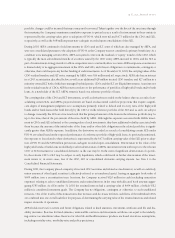American Express 2003 Annual Report Download - page 63
Download and view the complete annual report
Please find page 63 of the 2003 American Express annual report below. You can navigate through the pages in the report by either clicking on the pages listed below, or by using the keyword search tool below to find specific information within the annual report.
(p.61_axp_ financial review)
Investment income increased 11 percent in 2003 as higher levels of invested assets and the effect of appreciation in the S&P
500 on the value of options hedging outstanding stock market certificates and equity indexed annuities this year versus
depreciation last year, which was offset in the related provisions for losses and benefits, were partially offset by a lower aver-
age yield. During 2002, investment income increased significantly reflecting the effect of the $1.01 billion in investment
losses in 2001 noted previously, higher average invested assets and the effect of depreciation in the S&P 500 on the value
of options hedging stock market certificates and equity indexed annuities during 2002.
AEFA’s gross realized gains on sales of securities classified as Available-for-Sale, using the specific identification method,
were $323 million, $342 million and $157 million for the years ended December 31, 2003, 2002 and 2001, respectively.
Gross realized losses on sales were ($146 million), ($168 million) and ($529 million) for the same periods. AEFA also rec-
ognized losses of ($163 million), ($204 million) and ($428 million) in other-than-temporary impairments on Available-for-
Sale securities for the years ended December 31, 2003, 2002 and 2001, respectively. Realized gains and losses are recorded
in investment income.
Management and distribution fees rose 7 percent in 2003. Management fees increased 4 percent resulting from higher aver-
age assets under management reflecting the Threadneedle acquisition. Distribution fees increased 12 percent primarily due
to greater limited partnership product sales and an increase in brokerage-related activities. In 2002, management and dis-
tribution fees declined 7 percent due to lower average assets under management, partially offset by higher distribution fees.
The distribution fee increase was the result of lower mutual fund sales being more than offset by other product related
sales increases.
Other revenues rose 13 percent and 8 percent in 2003 and 2002, respectively, primarily due to higher property-casualty
and life insurance-related revenues coupled with higher financial planning and advice services fees.
In the following table, the Company presents AEFA’s aggregate revenues on a basis that is net of provisions for losses and
benefits because the Company manages the AEFA business and evaluates its financial performance, where appropriate, in
terms of the “spread” on its products. An important part of AEFA’s business is margin related, particularly the insurance,
annuity and certificate businesses.
One of the drivers for the AEFA business is the return on invested cash, primarily generated by sales of insurance, annuity
and investment certificates, less provisions for losses and benefits on these products. These investments tend to be interest
rate sensitive. Thus, GAAP revenues tend to be higher in periods of rising interest rates and lower in times of decreasing
interest rates. The same relationship is true of provisions for losses and benefits, only it is more accentuated period-to-period
because rates credited to customers’ accounts generally reset at shorter intervals than the yield on underlying investments.
The Company presents this portion of the AEFA business on a net basis to eliminate potentially less informative compar-
isons of period-to-period changes in revenue and provisions for losses and benefits in light of the impact of these changes
in interest rates.
Years Ended December 31, (Millions) 2003 2002 2001
Total GAAP revenues $6,172 $5,617 $ 4,791
Less: Provision for losses and benefits —
Annuities 1,104 1,034 989
Insurance 817 737 648
Investment certificates 201 183 329
Total 2,122 1,954 1,966
Net revenues $4,050 $3,663 $ 2,825
























